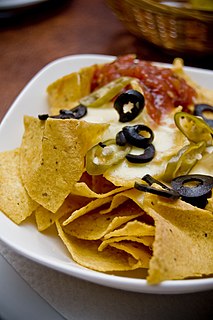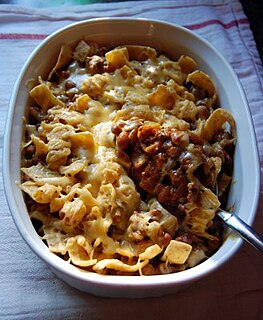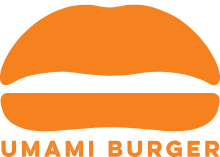
A taco is a traditional Mexican food consisting of a small hand-sized corn- or wheat-based tortilla topped with a filling. The tortilla is then folded around the filling and eaten by hand. A taco can be made with a variety of fillings, including beef, pork, chicken, seafood, beans, vegetables, and cheese, allowing for great versatility and variety. They are often garnished with various condiments, such as salsa, guacamole, or sour cream, and vegetables, such as lettuce, onion, tomatoes, and chiles. Tacos are a common form of antojitos, or Mexican street food, which have spread around the world.

A hamburger, or simply burger, is a food consisting of fillings—usually a patty of ground meat, typically beef—placed inside a sliced bun or bread roll. Hamburgers are often served with cheese, lettuce, tomato, onion, pickles, bacon, or chilis; condiments such as ketchup, mustard, mayonnaise, relish, or a "special sauce", often a variation of Thousand Island dressing; and are frequently placed on sesame seed buns. A hamburger patty topped with cheese is called a cheeseburger.

An enchilada is a Mexican dish consisting of a corn tortilla rolled around a filling and covered with a savory sauce. Enchiladas can be filled with various ingredients, including meats, cheese, beans, potatoes, vegetables, or combinations. Enchilada sauces include chili-based sauces, such as salsa roja, various moles, tomatillo-based sauces, such as salsa verde, or cheese-based sauces, such as chile con queso.

A fajita, in Tex-Mex cuisine, is any stripped grilled meat with stripped peppers and onions usually served on a flour or corn tortilla. The term originally referred to skirt steak, the cut of beef first used in the dish. Popular alternatives to skirt steak include chicken and other cuts of beef, as well as vegetables instead of meat. In restaurants, the meat is usually cooked with onions and bell peppers. Popular condiments include shredded lettuce, sour cream, guacamole, salsa, pico de gallo, shredded cheese, refried beans, and diced tomatoes. "Arrachera", another term for skirt steak, is also applied to a northern Mexican variant of the dish.

Nachos are a Mexican food consisting of fried tortilla chips or totopos covered with melted cheese or cheese sauce, as well as a variety of other toppings, often including meats, vegetables, and condiments such as salsa, guacamole, or sour cream. At its most basic form, nachos may consist of merely chips covered with cheese, and served as an appetizer or snack, while other versions are substantial enough as a main course. The dish was created by, and named after, Ignacio Anaya, who created them in 1941 for customers at the Victory Club restaurant in Piedras Negras, Coahuila.

Cheese fries or cheesy chips is a dish consisting of French fries covered in cheese, with the possible addition of various other toppings. Cheese fries are generally served as a lunch or dinner dish. They can be found in fast-food locations, diners, and grills around the globe.

Frito pie is a dish popular in the Midwestern, Southeastern, and Southwestern United States, whose basic ingredients are chili, cheese, and corn chips. Additions can include salsa, refried beans, sour cream, onion, rice, or jalapeños. There are many variations and alternative names used by region. Frito pie can be prepared in a casserole dish, but an alternate preparation can be in a single-serve Fritos-type corn chip bag with various ingredients as toppings. In Mexico a similar type of dish is chilaquiles.

A chalupa is a specialty dish of south-central Mexico, including the states of Hidalgo, Puebla, Guerrero, and Oaxaca.

A wrap is a food dish made with a soft flatbread rolled around a filling.

New Mexican cuisine is the cuisine of the Southwestern US state of New Mexico. The region is primarily known for its fusion of Pueblo Native American cuisine with Hispano Spanish and Mexican cuisine originating in Nuevo México.

A taquito, tacos dorados,rolled taco, or flauta is a Mexican food dish that typically consists of a small rolled-up tortilla that contains filling, including beef, cheese or chicken. The filled tortilla is then crisp-fried or deep-fried. The dish is often topped with condiments such as sour cream and guacamole. Corn tortillas are generally used to make taquitos. The dish is more commonly known as flautas when they are larger than their taquito counterparts, and can be made with either flour or corn tortillas.

A taco salad is a Tex-Mex dish that combines ingredients used in Tex-Mex tacos. The dish originated in Texas during the 1960s.

Taco rice is a popular example of modern Okinawan cuisine. It consists of taco-flavored ground beef served on a bed of rice, frequently served with shredded cheese, shredded lettuce, tomato and salsa.

Carne asada fries are a local specialty found on the menus of restaurants primarily in the American Southwest, including San Diego, where it originated. The dish is also served at Petco Park and Dodger Stadium. By 2015, fast food chain Del Taco began to sell the item.

A sope is a traditional Mexican dish consisting of a fried masa base with savory toppings. Also known as picadita, it originates in the central and southern parts of Mexico, where it was sometimes first known as pellizcadas. It is an antojito, which at first sight looks like an unusually thick tortilla with vegetables and meat toppings.

Mexican street food, called antojitos, is prepared by street vendors and at small traditional markets in Mexico. Street foods include tacos, tamales, gorditas, quesadillas, empalmes, tostadas, chalupa, elote, tlayudas, cemita, pambazo, empanada, nachos, chilaquiles, fajita and tortas, as well as fresh fruit, vegetables, beverages and soups such as menudo, pozole and pancita. Most are available in the morning and the evening, as mid-afternoon is the time for the main formal meal of the day.

Breaded cutlet is a dish made from coating a cutlet of meat with breading or batter and either frying or baking it. Breaded cutlet is known as schnitzel in German-speaking countries, cotoletta alla milanese in Italy, escalope in France, filete empanado in Spain, filete empanizado in Cuba, milanesa in Latin America, katsu in Japan and Korea, kotlet in Poland, řízek in Czech Republic and kotleta in post-Soviet countries.

Umami Burger is an American restaurant chain that specializes in gourmet hamburgers. The name refers to umami (savory) flavor. The restaurant was founded by Adam Fleischman, and is part of the Umami Restaurant Group. Umami Burger has waiter service and most locations have a full bar. Its first restaurant opened in Los Angeles in 2009. There were over 25 locations in California, Florida, Illinois, Japan, Nevada, and New York as of 2017.

A taco stand or taquería is a food stall, food cart or restaurant that specializes in tacos and other Mexican dishes. The food is typically prepared quickly and tends to be inexpensive. Many various ingredients may be used, and various taco styles may be served. Taco stands are an integral part of Mexican street food. Tacos became a part of traditional Mexican cuisine in the early 20th century, beginning in Mexico City, as what had been a miner's snack began to be sold on street corners in the city. Shops selling tacos have since proliferated throughout Mexico and other areas with a heavy Mexican culinary and cultural influence, including much of the Western United States and most other larger American cities. More typical taquerías specialize in tacos, as expected, but in some localities it can be used to refer to restaurants specializing in burritos, where tacos themselves are less of a point of emphasis.
Salsarita's Fresh Mexican Grill is a chain of fast casual Tex Mex restaurants in the United States serving Mexican-style cuisine. Restaurant service consists of: dine-in, take-out, online ordering, 3rd Party Delivery with some locations offering Drive Thru options. The company is headquartered in Charlotte, North Carolina, and operates over 80 company-owned and franchised restaurants throughout United States.



















